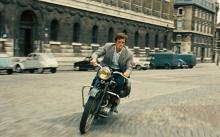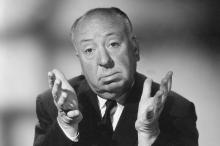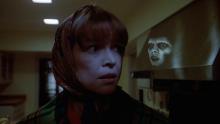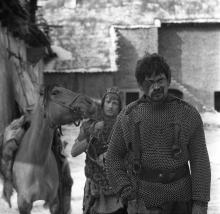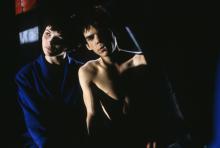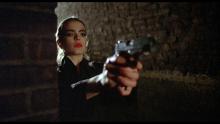By Jim Healy, UW Cinematheque Director of Programming
In the U.S. today, Jean-Paul Belmondo is still recognized as an iconic superstar of international cinema, but American audiences of today might not be quite as aware of the incredible range of this legendary performer. Belmondo is now best known for his leading roles in the groundbreaking features of the French nouvelle vague, films like Godard's Breathless (1960), A Woman is a Woman (1961) and Pierrot le fou (1965), Melville's Leon Morin, Priest (1961) and Le Doulos (1963), Truffaut's Mississippi Mermaid (1969) and Resnais' Stavisky (1974). Thanks to enterprising independent American distributors like Rialto Pictures and The Film Desk and specialty home video labels like The Criterion Collection, most of these Belmondo titles have been kept in circulation for American art house theaters and on DVD/Blu-Ray. But these New Wave movies represent the more cerebral side of Belmondo's filmography and only a small fraction of his more than 60 feature film appearances.
In Europe, Belmondo is much better known as a light-hearted man-of-action. A former boxer with a memorable mug that has earned him comparisons with Humphrey Bogart, Belmondo made several dozen films in his native France during the 1960s, 70s and 80s that exploit his marvelous physicality and his willingness to do his own stunts. These movies - some straight-forward action thrillers, some comic spoofs - frequently found Belmondo pairing with one of a handful of French directors who knew best how to capture the charisma and antics of this unique star. The most notable of these directors include Henri Verneuil, Georges Lautner and Jacques Deray, and, in fact, several of their Belmondo vehicles, like Deray's Borsalino (1970) and Verneuil's The Burglars (1971) were originally given wide releases in American theaters. That neither of these popular films have been made available on DVD in the U.S. is indicative of the access most American viewers have to Belmondo's less-serious side.
The auteur who gave Belmondo his greatest exposure as an action superstar was Philippe de Broca (1933-2004). Belmondo and de Broca made five features together, beginning with the 1962 swashbuckler Cartouche and ending with 1975's L'incorrigible. Over the next two Saturdays, October 18 and 25, the Cinematheque will present new restorations of their second and third collaborations, the rollicking action-comedies That Man from Rio (1964) and Up to His Ears (1965). An only partial listing of Belmondo's activities in That Man from Rio alone include: driving a tractor across an airport runway, skydiving into a jungle swamp (where he has a showdown with a live alligator!), clinging to the side of an eight-story building and swinging, Tarzan-style, from a vine. But if that's not enough for ya, here's a montage of awe-inspiring moments from over a dozen different movies where Belmondo, in the tradition of Buster Keaton and Jackie Chan, risks life and limb for your entertainment. This compilation includes clips from Verneuil's The Burglars and The Night Caller (aka Fear Over the City, 1975), as well as de Broca's Le Magnifique (1973), three fun movies that we included in our Cinematheque's Belmondo retrospective during the summer of 2011.
Like Keaton and Chan, Belmondo suffered numerous injuries for his art, including fractured hands and legs. A heavy metal pulley struck him in the face during the making of Hold-Up in 1985 and Belmondo swore off doing his own stunts from that point on. A stroke in 2001 has kept him almost entirely off-screen for the last decade but he returned to take on the leading role in Un Homme et son chien, a remake of Vittorio De Sica's Umberto D, in 2008. While we anxiously await his return to cinema screens, a few efforts by American distributors have been made to remind us of Belmondo's range and extraordinary use of his physical instrument. In 2012, Olive Films released DVDs and Blu-Rays of two Belmondo vehicles from the 60s, Gerard Oury's jokey The Brain (1969) and Verneuil's Green in the Sun (1964). The latter film, a lighter knock-off of Clouzot's The Wages of Fear, concludes with a rollicking bare-knuckle brawl between Belmondo and Lino Ventura.
Now, the good folks at Cohen Film Collection are theatrically re-releasing That Man from Rio in honor of its 50th anniversary. That Man from Rio was conceived in order to cash in on the growing popularity of the James Bond franchise, but Sean Connery's got nothing on Belmondo when it comes to action scenes. The film proved so popular everywhere it played (especially in the U.S.) that Belmondo and de Broca immediately teamed up again for Up to His Ears the very next year. Cohen has made both films available in new 2K restorations. That Man from Rio screens Saturday, October 18 at 7 p.m. and Up to His Ears screens Saturday, October 25 at 7 p.m. Both screenings in 4070 Vilas Hall, 821 University Avenue.

